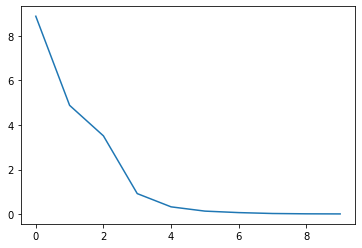Siamese Network using pytorch with simulated scatter plot data.
FullNotebook for the same using torch dataloader
Both the notebooks use the following data: DataUsed
The same should also work with a smaller version of MNIST data, see “MnistNotebook” and data “MNISTSmall”
%matplotlib inline
import matplotlib.pyplot as plt
import numpy as np
import random
from PIL import Image
import torch
from torch.autograd import Variable
import PIL.ImageOps
import torch.nn as nn
from torch import optim
import torch.nn.functional as F
import torchvision
import glob
from torchviz import *
POS_LABEL = 0 # Pair of Images that match
NEG_LABEL = 1 # Pair of Images that do not match
#If you reverse the labels, you have to change the Contrastive Loss function.
SZ = 128
MARGIN = 5.0
Model
class SiameseNetwork(nn.Module):
def __init__(self):
super(SiameseNetwork, self).__init__()
self.cnn1 = nn.Sequential(
nn.ReflectionPad2d(1),
nn.Conv2d(1, 4, kernel_size=3),
nn.ReLU(inplace=True),
nn.BatchNorm2d(4),
nn.ReflectionPad2d(1),
nn.Conv2d(4, 8, kernel_size=3),
nn.ReLU(inplace=True),
nn.BatchNorm2d(8),
nn.ReflectionPad2d(1),
nn.Conv2d(8, 8, kernel_size=3),
nn.ReLU(inplace=True),
nn.BatchNorm2d(8)
)
self.fc1 = nn.Sequential(
nn.Linear(8*SZ*SZ, 500),
nn.ReLU(inplace=True),
nn.Linear(500, 500),
nn.ReLU(inplace=True),
nn.Linear(500, 5))
def feature_extract(self, x):
output = self.cnn1(x)
output = output.view(output.size()[0], -1)
output = self.fc1(output)
return output
def forward(self, input1, input2):
output1 = self.feature_extract(input1) #extract features from image0
output2 = self.feature_extract(input2) #extract features from image1
return output1, output2
net = SiameseNetwork()
print(net)
X0 = torch.zeros((2,1, SZ, SZ)) #channel first (after batch)
X1 = torch.zeros((2,1, SZ, SZ)) #channel first (after batch)
d1,d2 = net(X0,X1)
SiameseNetwork(
(cnn1): Sequential(
(0): ReflectionPad2d((1, 1, 1, 1))
(1): Conv2d(1, 4, kernel_size=(3, 3), stride=(1, 1))
(2): ReLU(inplace=True)
(3): BatchNorm2d(4, eps=1e-05, momentum=0.1, affine=True, track_running_stats=True)
(4): ReflectionPad2d((1, 1, 1, 1))
(5): Conv2d(4, 8, kernel_size=(3, 3), stride=(1, 1))
(6): ReLU(inplace=True)
(7): BatchNorm2d(8, eps=1e-05, momentum=0.1, affine=True, track_running_stats=True)
(8): ReflectionPad2d((1, 1, 1, 1))
(9): Conv2d(8, 8, kernel_size=(3, 3), stride=(1, 1))
(10): ReLU(inplace=True)
(11): BatchNorm2d(8, eps=1e-05, momentum=0.1, affine=True, track_running_stats=True)
)
(fc1): Sequential(
(0): Linear(in_features=131072, out_features=500, bias=True)
(1): ReLU(inplace=True)
(2): Linear(in_features=500, out_features=500, bias=True)
(3): ReLU(inplace=True)
(4): Linear(in_features=500, out_features=5, bias=True)
)
)
Contrastive Loss function
class ContrastiveLoss(torch.nn.Module):
"""
Contrastive loss function.
Based on: http://yann.lecun.com/exdb/publis/pdf/hadsell-chopra-lecun-06.pdf
"""
def __init__(self, margin=MARGIN):
super(ContrastiveLoss, self).__init__()
self.margin = margin
def forward(self, output1, output2, label):
euclidean_distance = F.pairwise_distance(output1, output2, keepdim = True)
loss_contrastive = torch.mean((1-label) * torch.pow(euclidean_distance, 2) +
(label) * torch.pow(torch.clamp(self.margin - euclidean_distance, min=0.0), 2))
pred = (self.margin < euclidean_distance).type(torch.float)
return loss_contrastive, euclidean_distance, pred
BCELoss (did not do well)
#did not work well, you can try by setting criterion = SimpleBCELoss() below.
class SimpleBCELoss(torch.nn.Module):
def __init__(self):
super(SimpleBCELoss,self).__init__()
self.bce_loss = nn.BCELoss()
def forward(self,output1,output2,label):
edist = nn.PairwiseDistance(p=2,keepdim=True)(output1,output2)
edist = torch.sigmoid(edist)
loss_bce = self.bce_loss(edist,label)
return loss_bce
Make paired data
def get_positive_pairs(path='./data/mol_data/*'): #both images of same digit
positive_pairs = []
all_fam_dirs = glob.glob(path)
for famdir in all_fam_dirs:
mol_files = glob.glob(famdir+'/*.png')
for ff1 in mol_files:
for ff2 in mol_files:
if ff1 < ff2:
positive_pairs.append((ff1,ff2))
return positive_pairs
def get_negative_pairs(path='./data/mol_data/*',cnt=100): #images are from different digits
negative_pairs = []
all_fam_dirs = glob.glob(path)
random.shuffle(all_fam_dirs)
all_fam_dirs_rev = all_fam_dirs[::-1] #reversed
for famdir1,famdir2 in zip(all_fam_dirs,all_fam_dirs_rev):
if famdir1!=famdir2:
mol_files_1 = glob.glob(famdir1+'/*.png')
mol_files_2 = glob.glob(famdir2+'/*.png')
for ff1 in mol_files_1:
for ff2 in mol_files_2:
negative_pairs.append((ff1,ff2))
if len(negative_pairs) >= cnt:
break
return negative_pairs
def read_img(img_path):
img = Image.open(img_path)
img = img.convert('L')
img = img.resize((SZ,SZ))
img = np.asarray(img,dtype=np.float32)/255.0
return img
def build_paired_data(path,shuffle):
positive_pairs = get_positive_pairs(path)
negative_pairs = get_negative_pairs(path,len(positive_pairs))
print('Got ',len(positive_pairs),'positive_pairs')
print('Got ',len(negative_pairs),'negative_pairs')
if shuffle:
random.shuffle(positive_pairs)
random.shuffle(negative_pairs)
positive_labels = [POS_LABEL]*len(positive_pairs)
negative_labels = [NEG_LABEL]*len(negative_pairs)
all_pairs = positive_pairs + negative_pairs
all_labels = positive_labels + negative_labels
data = list(zip(all_pairs,all_labels))
random.shuffle(data)
print('Loading data size',len(data))
pairImages = []
pairLabels = []
pairNames = []
for image_pair,label in data:
img0 = read_img(image_pair[0])
img1 = read_img(image_pair[1])
pairImages.append([img0,img1])
pairLabels.append([label]) #very important to have labels as shape `batch_size` x 1
pairNames.append([image_pair[0],image_pair[1]])
return np.expand_dims(np.array(pairImages),axis=2), np.array(pairLabels), np.array(pairNames)
pairTrain, labelTrain, pairNames = build_paired_data('./data/mol_data/*',True)
print(pairTrain.shape, labelTrain.shape)
Got 200 positive_pairs
Got 200 negative_pairs
Loading data size 400
(400, 2, 1, 128, 128) (400, 1)
Create Siamese network and train
new_net = SiameseNetwork().cuda()
criterion = ContrastiveLoss()
optimizer = optim.Adam(new_net.parameters(),lr = 0.0005)
num_epochs = 10
batch_size = 64
num_batches = len(pairTrain) // batch_size
counter = []
loss_history = []
itr_no = 0
for epoch in range(num_epochs):
epoch_loss = [] # Sum of training loss, no. of tokens
epoch_accuracy = []
for batch_no in range(num_batches):
optimizer.zero_grad()
# Local batches and labels
X = pairTrain[batch_no*batch_size:(batch_no+1)*batch_size,]
y = labelTrain[batch_no*batch_size:(batch_no+1)*batch_size,]
X0 = torch.tensor(X[:, 0]).float().cuda()
X1 = torch.tensor(X[:, 1]).float().cuda()
Y = torch.tensor(y).float().cuda()
output1,output2 = new_net(X0,X1)
loss_contrastive, edist, predictions = criterion(output1,output2,Y)
loss_contrastive.backward()
optimizer.step()
epoch_loss.append(loss_contrastive.item())
acc = (Y==predictions).type(torch.float).cpu().numpy()
epoch_accuracy.extend(acc)
epoch_loss = np.mean(epoch_loss)
print('epoch',epoch,'loss=',epoch_loss,'acc=',np.mean(epoch_accuracy))
loss_history.append(epoch_loss)
counter.append(epoch)
epoch 0 loss= 8.871821959813436 acc= 0.8203125
epoch 1 loss= 4.87911335627238 acc= 0.9505208
epoch 2 loss= 3.5122199058532715 acc= 0.9244792
epoch 3 loss= 0.9253520170847574 acc= 0.9661458
epoch 4 loss= 0.33208129554986954 acc= 0.984375
epoch 5 loss= 0.1407537336150805 acc= 0.9895833
epoch 6 loss= 0.07411744073033333 acc= 1.0
epoch 7 loss= 0.033875590190291405 acc= 0.9895833
epoch 8 loss= 0.019601694618662197 acc= 1.0
epoch 9 loss= 0.015237660147249699 acc= 1.0
Plot training loss
def show_plot(iteration,loss):
plt.plot(iteration,loss)
plt.show()
show_plot(counter,loss_history)

Visualize dynamic graph
make_dot(loss_contrastive)
Warning: Could not load "/opt/conda/lib/graphviz/libgvplugin_pango.so.6" - file not found
 |
Plot some images and their predictions
def imshow(img,text=None,should_save=False):
npimg = img.numpy()
plt.axis("off")
if text:
plt.text(280, 10, text, style='italic',fontweight='bold',
bbox={'facecolor':'white', 'alpha':0.8, 'pad':10})
plt.imshow(np.transpose(npimg, (1, 2, 0)))
plt.show()
X = pairTrain[100:110,]
y = labelTrain[100:110,]
X0 = torch.tensor(X[:, 0]).float().cuda()
X1 = torch.tensor(X[:, 1]).float().cuda()
Y = torch.tensor(y).float().cuda()
output1,output2 = new_net(X0,X1)
loss_contrastive, edist, predictions = criterion(output1,output2,Y)
#edist = F.pairwise_distance(output1, output2, keepdim = True)
for i in range(10):
z = torch.cat((X0[i:i+1],X1[i:i+1]),0).cpu()
d = edist[i].cpu().item()
pred = int(predictions[i].cpu().item())
imshow(torchvision.utils.make_grid(z),'Dissimilarity: {:.2f} {}'.format(d,pred))










Written on
